Philips VR 742, VR 740, VR840 User Manual

Table of Contents
1. Connecting the video recorder . . . . . . . . . . |
. .4 |
Important for the United Kingdom . . . . . . . . . . |
.4 |
Preparing the remote control for operation . . . . |
.4 |
Connecting your video recorder to the TV set |
. .4 |
Connecting with a scart cable and |
|
‘Easy Link’ [VR840] . . . . . . . . . . . . . . . . . . . . . |
.4 |
Connecting with a scart cable . . . . . . . . . . . . . . |
.5 |
Connecting without a scart cable . . . . . . . . . . . |
.6 |
Audio output Connection . . . . . . . . . . . . . . . . . |
.6 |
Connecting additional devices . . . . . . . . . . . . . |
.6 |
2. Important notes for operation . . . . . . . . . . . . . .7
Navigation in the screen menu . . . . . . . . . . . . .7 The symbols on your video recorder display . . .7
3. Installing your video recorder . . . . . . . . . |
. . . .8 |
Preparation for use . . . . . . . . . . . . . . . . . . . |
. . .8 |
Decoder allocation . . . . . . . . . . . . . . . . . . . |
. . .8 |
Manual TV channel search . . . . . . . . . . . . . |
. . .9 |
Using the satellite receiver . . . . . . . . . . . . . . |
. . .9 |
Follow TV (Automatic TV channels sorting) |
. . .10 |
Automatic Tuning . . . . . . . . . . . . . . . . . . . . . |
. .10 |
Sorting and clearing TV channels manually . |
. .11 |
Setting the clock . . . . . . . . . . . . . . . . . . . . . |
. .11 |
Setting the RF out channel . . . . . . . . . . . . . |
. .12 |
4. Playback . . . . . . . . . . . . . . . . . . . . . . . . . . . |
. .13 |
Playing cassettes . . . . . . . . . . . . . . . . . . . . |
. .13 |
Playing back NTSC cassettes . . . . . . . . . . . |
. .13 |
Displaying current tape position . . . . . . . . . . |
. .13 |
Searching for a tape position |
|
with picture(scanning) . . . . . . . . . . . . . . . . . |
. .14 |
Still picture / slow motion . . . . . . . . . . . . . . . |
. .14 |
Searching for tape position without picture |
|
(forward wind and rewind) . . . . . . . . . . . . . . |
. .14 |
Index search . . . . . . . . . . . . . . . . . . . . . . . |
. .14 |
Changing the picture setting |
|
Smart picture [VR840] . . . . . . . . . . . . . . . . . |
. .14 |
Manual Tracking . . . . . . . . . . . . . . . . . . . . . |
. .14 |
5. Manual recording . . . . . . . . . . . . . . . . . . . . . . .15
General information . . . . . . . . . . . . . . . . . . . . .15 Recording without automatic switch-off . . . . . .15 Preventing accidental erasing . . . . . . . . . . . . .15 Lining up recordings (assemble cut) . . . . . . . .15 Selecting the recording speed (SP or LP) . . . .16 Automatic controlled recording from
a satellite receiver (RECORD LINK) . . . . . . . .16 'Direct Record' . . . . . . . . . . . . . . . . . . . . . . . . .17 Switching 'Direct Record' on or off . . . . . . . . . .17
6. Programming a recording (TIMER) . . . . . . . . .18
General information . . . . . . . . . . . . . . . . . . . . .18 Programming a recording
(with the 'VIDEO Plus+® system') . . . . . . . . . . .18 Helpful Hints . . . . . . . . . . . . . . . . . . . . . . . . . .19 Programming a recording
(without the VIDEO Plus+® system) . . . . . . . . .19 Helpful Hints . . . . . . . . . . . . . . . . . . . . . . . . . .20 Programming a recording with
'TURBO TIMER' . . . . . . . . . . . . . . . . . . . . . . .20 Helpful Hints . . . . . . . . . . . . . . . . . . . . . . . . . .21 How to check, or delete a programmed
recording (TIMER) . . . . . . . . . . . . . . . . . . . . . .21 How to change a programmed
recording(TIMER) . . . . . . . . . . . . . . . . . . . . . .21 NexTView Link [VR840] . . . . . . . . . . . . . . . . . .21
7. Other functions . . . . . . . . . . . . . . . . . . . . . . . .22
Switching the status display off or on . . . . . . . .22 Blue Background on or off . . . . . . . . . . . . . . . .22 Automatic switch-off . . . . . . . . . . . . . . . . . . . .22 Clock display . . . . . . . . . . . . . . . . . . . . . . . . . .23 Selecting the sound channel . . . . . . . . . . . . . .23
8.Before you call an engineer . . . . . . . . . . . . . . .24
Interference
The Department of Trade and industry operates a Radio Investigation Service to help TV licence holders improve reception of BBC and ITC programmes where these are being spoilt by interference.
If your dealer cannot help, ask at a Main Post Office for the booklet 'How to lmprove Television and Radio Reception'.
Supplied accessories
•Operating instructions
•Remote control and batteries
•Aerial cable
3 |
EN |
|

VCR
VR740/07
VR742/07
VR840/07
[VR740/07]
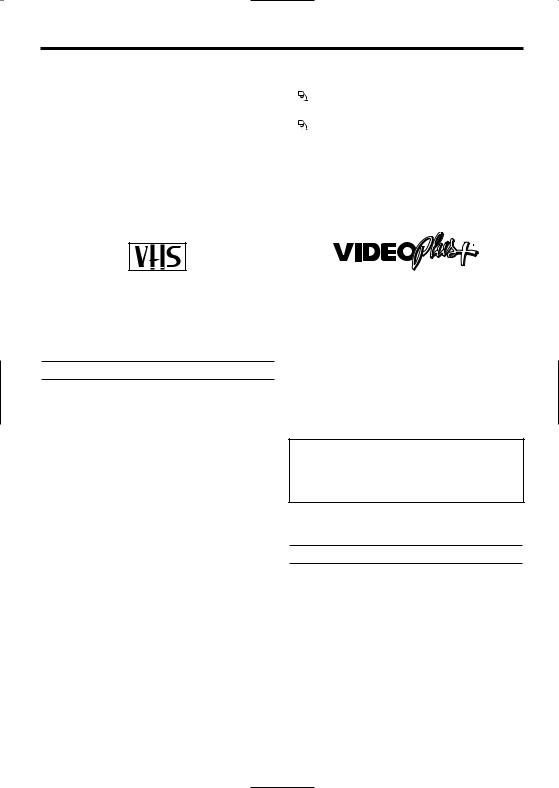
OPERATING INSTRUCTIONS
Thank you for buying a Philips video recorder. This video recorder is one of the most sophisticated and easy-to-use video recorders (VCR) on the market. Please take the time to read this operating manual before using your video recorder. It contains important information and notes regarding operation. The video recorder should not be turned on immediately after transportation from a cold to a hot area or vice versa, or in conditions of extreme humidity. Wait at least three hours after transporting the device. The video recorder needs this time in order to become acclimatised to its new environment (temperature, air humidity, etc.).
PAL
This video recorder is used for the recording and playback of VHS video cassettes. Cassettes with the VHS-C label (VHS cassettes for camcorders) may only be used with a suitable adapter.
We hope you enjoy your new video recorder.
Important notes regarding operation
"Danger: High voltage!
Do not remove the top cover as there is a risk of an electrical shock!
The video recorder does not contain any
"components that can be repaired by the customer. Please leave all maintenance work for qualified personnel.
As soon as the video recorder is connected
"to the power supply, there are some components that are in constant operation. To switch off the video recorder completely you must disconnect it from the power supply.
Make sure that air can circulate freely
!through the ventilation slots on the video recorder. Do not place the device on an unsteady base.
Make sure that no objects or liquids enter
!the video recorder. Do not place vases or the like on the video recorder. If liquid is spilt into it, immediately disconnect the video recorder from the power supply and call After-sales Service for advice.
!Do not place any combustible objects on the device (candles, etc.).
!Make sure that children do not place any foreign objects within the openings or ventilation slots.
 These operating instructions have been
These operating instructions have been  printed on non-polluting paper.
printed on non-polluting paper.
 Deposit old batteries at the appropriate col-
Deposit old batteries at the appropriate col-  lection points.
lection points.
 Please make use of the facilities available in
Please make use of the facilities available in  your country for disposing of the packaging of the video recorder in a way that helps to protect the environment.
your country for disposing of the packaging of the video recorder in a way that helps to protect the environment.
 This electronic device contains many mate-
This electronic device contains many mate-  rials that can be recycled. Please enquire about the possibilities for recycling your old device.
rials that can be recycled. Please enquire about the possibilities for recycling your old device.
VIDEO Plus+ and PlusCode are registered trademarks of Gemstar Development Corporation. The VIDEO Plus+ system is manufactured under license from Gemstar Development Corporation.
So that you can identify your machine for service questions or in the event of theft, enter the serial number here. The serial number (PROD.NO.) is printed on the type plate fixed at the back of the device. Also, we suggest that you put a mark with your VCR MODEL NO..
MODEL NO. VR740/07, VR742/07,
VR840/07
PROD. NO. ..........................
This product complies with the requirements of Directive 73/23/EEC +89/336/EEC +93/68 EEC.
Specifications
Voltage: 230-240V/50Hz
Power consumption : 20W
Power consumption (Standby): less than 3W (PWR. in the display switched off)
Rewind time: approx. 70 seconds (cassette E-180)
Dimensions in cm (WxDxH): 43.5x22.6x9.2 Number of video heads : 4
Number of video heads (HIFI): 2
Recording/playback time:
3 hours (SP) (cassette E-180)
6 hours (LP) (cassette E-180)
2 |
EN |
|
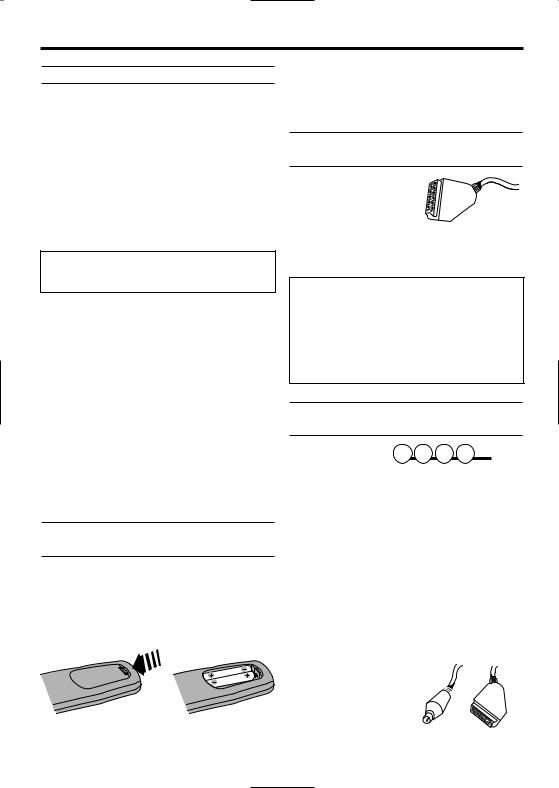
1. Connecting the video recorder
Important for the United Kingdom
This apparatus is fitted with an approved moulded 10 Amp plug. To change a fuse in this type of plug proceed as follows:
1.Remove fuse cover and fuse.
2.Fix new fuse which should be a BS1362 3A,ASTA or BSI approved type.
3.Refit the fuse cover.
If the fitted plug is not suitable for your socket outlets, it should be cut off and an appropriate plug fitted in its place.
If the mains plug contains a fuse, this should have a value of 3A. If a plug without a fuse is used, the fuse at the distribution board should not be greater than 3A.
The severed plug must be destroyed to avoid a possible shock hazard should it be inserted into a 13A socket elsewhere.
How to connect a plug:
The wires in the mains lead are coloured in accordance with the following code:
BLUE- 'NEUTRAL' ('N') BROWN- 'LIVE' ('L')
4.The BLUE wire must be connected to the terminal which is marked with the letter 'N' or coloured BLACK.
5.The BROWN wire must be connected to the terminal which is marked with the letter 'L' or coloured RED.
6.Do not connect either wires to the earth terminal in the plug which is marked with the letter 'E' or by the safety earth symbol  or coloured green or green-and-yellow.
or coloured green or green-and-yellow.
Before replacing the plug cover, make certain that the cord grip is clamped over the sheath of the lead-not imply over the two wires.
Preparing the remote control for operation
The remote control and its batteries are packed separately in the original video recorder packaging. You must install the batteries in the remote control before use.
1.Take the remote control and the enclosed batteries (2 batteries).
2.Open the remote control's battery compartment and place the batteries in it as shown in the picture and close the battery component.
The remote control is now ready to use. Its range is approximately 5 metres.
Connecting your video recorder to the TV set
The necessary cable
connections must be made before you can
record or playback TV  programmes using your video recorder.
programmes using your video recorder.
We recommend that you use a scart cable to connect your TV and video recorder.
What is a scart cable?
The scart or Euro AV cable serves as the universal connector for picture, sound and control signals. With this type of connection, there is practically no loss of quality during the picture or sound transfer.
*You can have the Hi-fi sound on the TV only with a scart cable.
Connecting with a scart cable and 'Easy Link' [VR840]
 L I N K
L I N K
What is Easy Link?
Easy Link is a system which allows advanced communication between the different elements of the Audio and Video chain (TV, VCR, DVD,
Dolby Surround amplifier etc...)
If both your TV and your VCR are equipped with one of the following features:
Easy Link, NextView Link, TV Link Smart Link, Q Link, Cinema Link (all compatible with one another), your VCR can exchange information with your TV. For example, the channels will automatically be transferred in the same order from your TV to your video recorder during the
initial installation. |
|
|
Have the following |
|
|
cables ready: an aerial |
|
|
cable (1, supplied), a |
|
|
scart cable (2, not sup- |
|
|
plied). |
1 |
2 |
4 |
EN |
|
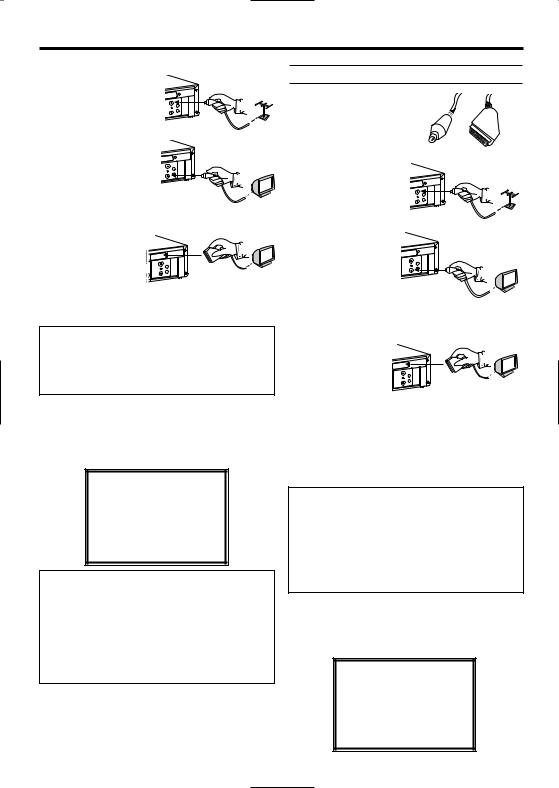
1.Switch off your TV set.
2.Remove the
cable plug from |
|
|
AV 1 (TV) |
|
AERIAL |
|
|
|
|
|
|
TV set. Insert it |
|
|
|
AUDIO |
|
|
|
|
OUTPUT |
|
|
|
|
AERIAL |
L |
|
|
|
|
RF OUT |
R |
|
|
AERIAL at the |
|
|
|
|
|
the video recorder. |
|
|
|
|
|
3.Insert one end |
|
|
|
|
|
supplied aerial |
|
AV 1 |
(TV) |
|
|
|
|
AUDIO |
RF OUT |
||
into the RF |
|
|
OUTPUT |
||
|
|
AERIAL |
L |
|
|
|
|
RF OUT |
R |
|
|
|
|
|
|
|
|
the back of the |
|
|
|
|
|
recorder and the |
|
|
|
|
|
other end into the |
|
|
|
|
|
aerial input socket at the back of the TV set. |
|||||
4.Plug in a scart |
|
|
|
|
|
cable into the |
AV 1 |
(TV) |
|
|
|
|
|
|
|
|
|
scart socket |
|
|
AUDIO |
|
|
|
|
OUTPUT |
|
|
|
|
AERIAL |
L |
|
AV1(TV) |
|
|
|
|
|||
(TV) at the |
|
RF OUT |
R |
|
|
|
|
|
|
||
|
|
|
|
|
|
the video recorder and the scart socket on |
|||||
the TV set reserved for the video recorder |
|||||
operation (see TV set operating instructions).
My TV set has several scart sockets. Which one should I use?
Please see the operating instructions of your TV set to find out which socket supports 'Easy Link'.
5.Switch on the TV set.
6.Insert AC cable into the wall socket.
7.Switch on this video recorder.
8.The following screen will appear on the TV screen.
PLEASE CONNECT AERIAL OR
CABLE TO THE VCR
THEN...
PUSH P+ KEY
OR...
FOR PLAY ONLY - PUSH PLAY
The video recorder does not find any TV channels during the search
*Select channel 1 on the TV. Can you see the saved TV channel on the TV?
If not, check the cable connection of the aerial (aerial socket), video recorder, TV.
*The video recorder searches the entire frequency range in order to find and save the largest possible number of TV channels.
Then, read the paragraph ‘Preparation for use’ in the chapter ‘Installing your video recorder’.
Connecting with a scart cable
Have the following |
|
|
|
|
|
|
cables ready: |
|
|
|
|
|
|
an aerial cable (1, sup- |
|
|
|
|
|
|
plied), a scart cable (2, |
|
|
|
1 |
2 |
|
not supplied). |
|
|
|
|
||
|
|
|
|
|
|
|
1.Remove the aerial |
|
|
|
|
|
|
cable plug from your |
AV 1 |
(TV) |
AERIAL |
|
||
TV set. Insert it into |
|
|
|
AUDIO |
|
|
|
|
|
OUTPUT |
|
||
the AERIAL at the |
|
|
|
AERIAL |
L |
|
|
|
|
RF OUT |
R |
|
|
|
|
|
|
|
|
|
back of the video |
|
|
|
|
|
|
recorder. |
|
|
|
|
|
|
2.Insert one end |
|
|
|
|
|
|
the supplied |
|
AV 1 (TV) |
|
|
|
|
|
|
|
AUDIO |
RF OUT |
|
|
cable into the |
|
|
|
OUTPUT |
|
|
|
|
AERIAL |
L |
|
|
|
|
|
RF OUT |
R |
|
|
|
|
|
|
|
|
|
|
OUT at the |
|
|
|
|
|
|
the video recorder |
|
|
|
|
|
|
and the other end |
|
|
|
|
|
|
into the aerial |
|
|
|
|
|
|
input socket at the back of the TV set. |
|
|||||
3.Plug one end |
|
|
|
|
|
|
scart cable |
AV 1 |
(TV) |
|
|
|
|
the scart |
|
|
AUDIO |
|
|
|
|
AERIAL |
OUTPUTL |
|
AV1(TV) |
|
|
AV1(TV) at |
|
RF OUT |
R |
|
|
|
|
|
|
|
|
||
back of the video |
|
|
|
|
|
|
recorder and the other end into the suitable |
||||||
scart socket on your TV reserved for the |
|
|||||
video recorder operation (see your TV's oper- |
||||||
ating instructions). |
|
|
|
|
|
|
4.Switch on the TV. |
|
|
|
|
|
|
5.Insert AC cable into the wall socket. |
|
|||||
My TV has several scart sockets. Which one should I use?
Select that scart socket which is suited for the video output as well as for the video input.
My TV has a configuration menu for the scart socket.
Please configure this scart socket as InputOutput.
6.If the connection was properly made and your TV was automatically switched to the programme number for the scart socket, you will see the following picture:
PLEASE CONNECT AERIAL OR
CABLE TO THE VCR
THEN...
PUSH P+ KEY
OR...
FOR PLAY ONLY - PUSH PLAY
5 |
EN |
|
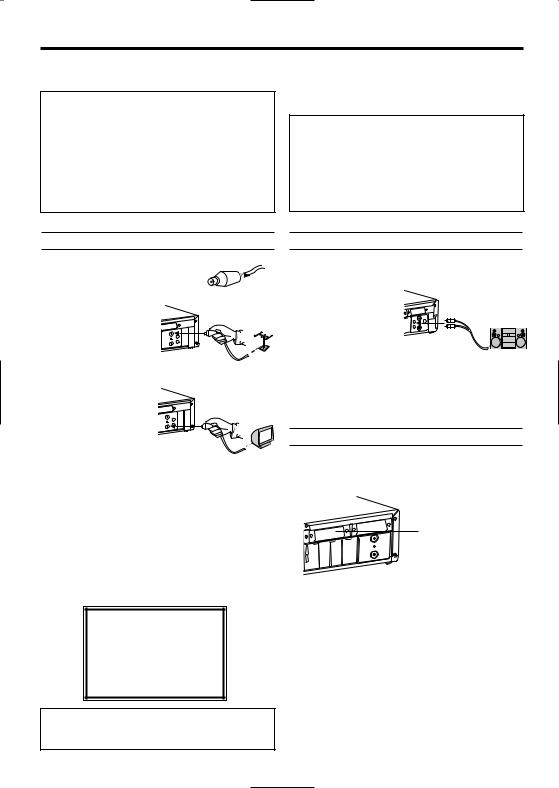
Then, read the paragraph 'Preparation for use' in the chapter 'Installing your video recorder'.
My screen is empty
*Many TV sets are switched to the programme number for the scart socket by way of a control signal sent through the scart cable.
*If the TV set does not automatically switch to the scart socket programme number, manually change to the corresponding programme number on your TV set (see your TV's operating instructions).
7.Save this programme number setting on your
TV set for video recorder operation.
You can find more details in chapter 'Preparation for use'.
Programme number for video recorder operation
You have now saved a programme number for use by your video recorder as you would a regular TV channel. This programme number must now be used in future for video recorder playback ('video recorder' TV channel).
Connecting without a scart cable
Have an aerial cable ready (supplied).
1.Switch off your TV set. |
|
|
|
|
|
2.Remove the aerial |
|
|
|
|
|
cable plug from the |
|
AV 1 |
(TV) |
|
AERIAL |
aerial input socket of |
|
|
|
AUDIO |
|
|
|
|
OUTPUT |
|
|
the TV set. Insert it |
|
|
AERIAL |
L |
|
|
|
RF OUT |
R |
|
|
|
|
|
|
|
|
into the AERIAL at |
|
|
|
|
|
the back of the video |
|
|
|
|
|
recorder. |
|
|
|
|
|
3.Insert one end of the |
|
|
|
|
|
supplied aerial cable |
AV 1 |
(TV) |
|
|
|
|
|
|
|
RF OUT |
|
into the RF OUT at |
|
|
AUDIO |
||
|
|
OUTPUT |
|||
|
AERIAL |
L |
|
||
|
RF OUT |
R |
|
||
the back of the video recorder and the other end into the
aerial input socket at the back of the TV set.
4.Insert AC cable into the wall socket.
5.Switch on your TV set and select the programme number used for video playback on your TV set (see your TV's operating instructions).
6.Select this programme number and manually start the TV's channel search as if you wanted to save a new TV channel until the 'test image' appears.
PLEASE CONNECT AERIAL OR
CABLE TO THE VCR
THEN...
PUSH P+ KEY
OR...
FOR PLAY ONLY - PUSH PLAY
I do not see a TV channel search picture
*Check the cable connections.
*Repeat the channel search on your TV.
Audio output Connection
Prepare an audio cable (not supplied).
1.Switch off your audio amplifier.
2.Insert one end of
the audio cable into |
AV1 |
(TV) |
|
|
|
||
the corresponding |
AUDIO |
|
IR-SAT |
OUTPUTL AERIAL |
|
||
red and white |
RF OUT |
|
|
R |
|
|
|
|
|
|
|
AUDIO OUTPUT L/R socket at the
back of the video recorder and the other end into the corresponding audio input socket at the back of the audio amplifier.
Connecting additional devices
You can connect additional devices such as decoders, satellite receivers, camcorders, etc. to the socket AV2(DECODER).
AV1 (TV)
AV2 (DECODER)
AV2(DECODER)
AERIAL
RF OUT
6 |
EN |
|
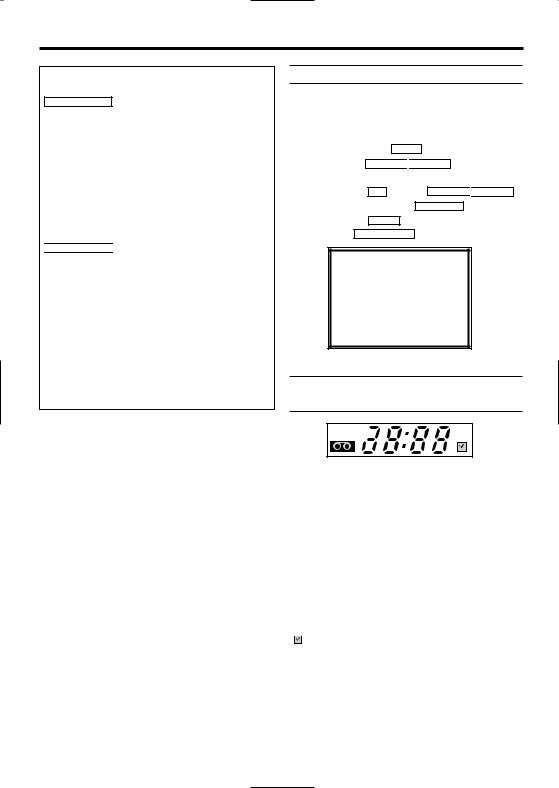
2. Important notes for operation
Switching on
You can switch on the video recorder with the
STANDBY/ON y button.
Automatic switch-off
If the video recorder is not used for several minutes, it switches itself off automatically. This function can be deactivated (e.g. if you want to use the video recorder as a TV receiver). For more information, please read the section 'Automatic switch-off' in chapter 'Other functions'.
Time in the display
If you have switched the video recorder off with

 , the time will show in the display, e.g. '18:00'.
, the time will show in the display, e.g. '18:00'.
If the clock has not been set, ' --:-- ' will appear.
Power consumption
The video recorder should always be connected to the mains so as not to affect the use of the
TV or programmed recordings.
If the display has been switched off, your video recorder consumes less than 3W in stand-by.
Power outage/no power
Channel information remains saved for up to 10 year, the time and timer information is saved for up to 1 minute.
Navigation in the screen menu
You can check/change many functions and settings of your video recorder via the on-screen menu. The individual functions are selected, via the remote control as follows:
Call up the menu: with MENU .
To select: with PLAY B-K 
 STOP C-L .
STOP C-L .
To enter or change your selection: with the number buttons 0..9 or with PLAY B-K 
 STOP C-L .
STOP C-L .
To save or confirm: with FWD 1- B . To cancel: with CLEAR .
To end: with STATUS/EXIT .
SELECT K L CHOOSE B
→TIMER
RECORD SET UP VCR SET UP TUNER SET UP INITIAL SET UP
END=EXIT
The symbols on your video recorder display
PWR. |
REC |
These symbols can light up on your video recorder display:
PWR When you keep your video recorder on.
 When you have put a cassette in the video recorder.
When you have put a cassette in the video recorder.




 Display of programme number of the TV channel / time / RF channel.
Display of programme number of the TV channel / time / RF channel.
REC When you record.
When you have programmed a recording.
7 |
EN |
|

3. Installing your video recorder
Preparation for use
This chapter shows you how to prepare the video recorder for use. The video recorder automatically seeks out and stores all available TV channels.
'Aim' correctly
In the following sections, you require the remote control for the first time. When using, always aim the front of the remote control at the video recorder and not at the TV.
Connecting additional devices
After you have connected additional devices (satellite receiver, etc.) through the aerial cable, switch them on. The automatic channel search will recognise them and save them.
1.Press 
 .
.
The automatic channel search starts.
PLEASE WAIT
START |
FINISH |
TIME --:--
DATE --/--/--
SMART CLOCK [ON]
END=EXIT
4.Check if the displayed settings for 'DAY', 'MONTH' and 'YEAR' are correct.
5.When all information is correct, save by pressing STATUS/EXIT .
The preparation for use is now complete.
If you connect the VCR to a TV equipped with
Easy Link, the preset download will automatically be performed and the following OSD will appear on the TV [VR840 only].
PRESET DOWNLOAD
PLEASE WAIT...
2.'TIME' and 'DATE' will appear on the TV screen.
3.Check 'TIME'. If required, please change the time with the number buttons  .
.
The video recorder does not find any TV channels during the search
*Select channel 1 on the TV. Can you see the saved TV channel on the TV?
If not, check the cable connection of the aerial (aerial socket), video recorder, TV.
*The video recorder searches the entire frequency range in order to find and save the largest possible number of TV channels. It is possible that the TV channels in your country are broadcast in a higher frequency range. As soon as this range is reached during the search, the video recorder will find the TV channels.
8
